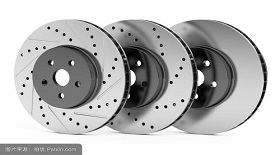Block type of brake
The brakes for cranes are made up of brake blocks, brake arms, brake wheels and sluice gates. The brake wheel is usually installed on the rotating shaft of the mechanism as a half-body of the coupling. The symmetrically arranged brake arm is hinged with the fixed part of the frame. The two brake pads with friction material on the inside are respectively movably hinged on the two brake arms. Brake torque is generated.
When the power supply is switched on, the iron core of the electromagnetic loosener attracts the armature to the push rod, which pushes the left brake arm to the left, and the main spring is compressed. At the same time, the relieving auxiliary spring pushes the right brake arm to the right, and the two brake arms drive the brake pad and the brake wheel to separate, so the mechanism can move. When the power supply is cut off, the core loses magnetism and the attraction of the armature is eliminated, relieving the pressure of the armature on the push rod. Under the action of the main spring tension, the two brake arms swing inward together to drive the brake pad to hold the brake wheel and generate brake torque. At the same time, the auxiliary spring is compressed. The brake torque is determined by the main spring force, and the auxiliary spring ensures the clearance between the loosening members. The brake performance of the block brake is largely determined by the performance of the brake.



